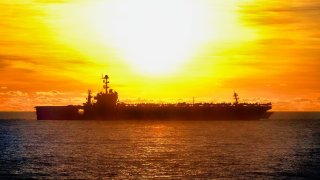How Many Aircraft Carriers will China End Up Building?
China's pursuit of a fourth aircraft carrier, potentially embracing nuclear propulsion, highlights its ambitions for a blue-water navy capable of extended global reach.
Summary: China's pursuit of a fourth aircraft carrier, potentially embracing nuclear propulsion, highlights its ambitions for a blue-water navy capable of extended global reach. While this development is a step toward matching the operational capacities of the U.S. Navy, China's naval expansion also underscores the intensifying military rivalry between Washington and Beijing. Despite the advancements, the PLAN has a considerable journey ahead to match the U.S. in carrier strength, indicating a long-term challenge in the strategic balance of maritime power.
China's Aircraft Carrier Dreams: Becoming Reality?
Reports across Chinese media indicate a fourth aircraft carrier could soon join the People’s Liberation Army Navy (PLAN). The South China Morning Post, Global Times, and Hong Kong Commercial Daily have all alluded to the development of a fourth ship.
China currently possesses three aircraft carriers: the Liaoning, Shandong, and Fujian. While each warship has added better capabilities than the one before it, none is powered by nuclear energy, which enables ships to sail for much longer than ships powered by diesel and electric sources. As of April 2024, the U.S. Navy has 11 large nuclear-powered carriers. In order for Beijing to compete with this arsenal, it needs to play catch-up.
Introducing Liaoning (Type 001)
Following the dissolution of the Soviet Union, China acquired the Kuznetsov-class Varyag carrier. Refurbishment of the warship, renamed Liaoning, was completed in 2011.
The vessel was initially classified as a training ship, but it transitioned into a combat role in 2019. This Type 001 Chinese carrier received an array of overhauls over the years to qualify as a real floating airport. Reportedly, a Type 348 active electronically scanned array radar and Sea Eagle radar were installed on the ship. An air defense system consisting of the Type 1130 close-in weapons system and the HQ-10 missile system were also reportedly incorporated.
Introducing Shandong (Type 002)
The second carrier to enter service with the PLAN was the Shandong Type 002 warship. She launched in 2017 as China’s first domestically built aircraft carrier.
Although Beijing did not reveal details surrounding the vessel until after the construction phase was well underway, satellite imagery confirmed the ship’s production process. The Shandong was officially commissioned in 2019 and participated in the country’s United Sharp Sword military exercises in 2023.
Introducing Fujian (Type 003) Aircraft Carrier
The Fujian is the latest Chinese carrier to enter service with the PLAN. This Type 003 warship was constructed without a ski ramp, reportedly using an electromagnetic aircraft launch system (EMALS) similar to the American EMALS incorporated on Ford-class carriers.
As the first Chinese carrier to support catapult-assisted take-offs, the Fujian is far more capable than its predecessors. The Fujian, which officially launched in 2022, exemplifies Beijing’s ambitious naval modernization efforts. It is currently Beijing’s most advanced aircraft carrier.
Notably, this warship is conventionally powered, unlike its American-made Nimitz- and Ford-class counterparts. If the PLAN is able to produce a nuclear-powered surface ship in the near future, it will mark a major milestone in ship development for Xi Jinping’s regime. Tensions between Washington and Beijing are continuing to ramp up, making China’s growing military power very concerning. But even if the fourth Chinese carrier is nuclear-powered, the U.S. Navy still has a far greater number of carriers on its side. Beijing will have to produce plenty more warships before it can match America’s carrier strength out at sea.
About the Author: Maya Carlin
Maya Carlin, National Security Writer with The National Interest, is an analyst with the Center for Security Policy and a former Anna Sobol Levy Fellow at IDC Herzliya in Israel. She has by-lines in many publications, including The National Interest, Jerusalem Post, and Times of Israel. You can follow her on Twitter: @MayaCarlin.
Image Credit: U.S. Navy.


